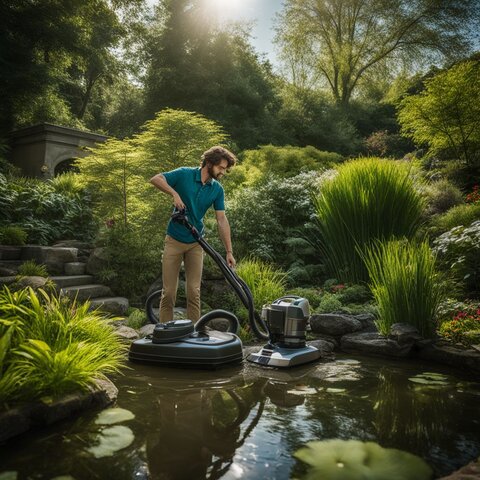
How Does A Pond Vacuum Work?
Knowing how does a pond vacuum work will help eliminate the challenge of cleaning a pond for many homeowners.
Pond vacuums are effective tools that remove muck and debris, keeping your water garden or koi pond healthy.
This article will guide you through how a pond vacuum works, making it simpler to keep your aquatic space in top condition.
Discover the benefits of using one today!
What is a Pond Vacuum?
A pond vacuum is a specialized tool designed specifically for cleaning ponds, including water gardens and koi ponds, by safely removing muck and debris.
It sucks up muck and debris to make the water clean and safe for fish. Unlike regular shop vacs, pond vacuums are gentle on plants and animals in the water.

Pond vacuums come equipped with filter nozzles designed to prevent objects larger than ⅜ of an inch from passing through, which helps protect fish and other aquatic life during the cleaning process.
These vacuum cleaners are important for keeping a pond healthy. Using one helps clear out organic material that can dirty the water.
Pond owners use these tools to maintain a good environment for their aquatic life without hurting them.
How Does a Pond Vacuum Work?
A pond vacuum uses a pump to create suction. This draws water, muck, and debris into a suction hose.
The debris passes through the nozzle, which filters out particles larger than ⅜ of an inch to protect fish and aquatic life.

Then, clean water flows back into the pond through a discharge hose. This process helps maintain clear water and healthy conditions for plants and fish.
While some pond vacuums discharge filtered water back into the pond, others collect debris in a collection bag or chamber, which must be emptied after cleaning.
It's important to follow the manufacturer's instructions for proper use and disposal of vacuumed debris.
The vacuum quickly picks up small and medium-sized debris without much change in water level.
It makes pond maintenance easier by reducing cleaning time and effort.
Next, let's explore the benefits of using a pond vacuum for your garden or koi pond.
Benefits of Using a Pond Vacuum
Using a pond vacuum helps keep the water clear and the aquatic environment healthy for fish, making it a valuable tool for pond owners.
Improved Pond Cleanliness
Using a pond vacuum regularly keeps the water clear and maintains a healthy environment for aquatic plants and fish.
This tool is great for keeping your fish ponds free of unwanted debris without disturbing the water too much.

Since it quickly removes small and medium-sized particles, it significantly reduces the effort and time needed to keep ponds clean.
Pond vacuums help maintain clear water by filtering out particles smaller than ⅜ of an inch.
This means that while cleaning, they are safe for fish and other aquatic life in your pond.
Clear water not only looks better but also improves conditions for underwater ecosystems to thrive by allowing more sunlight to penetrate deeper areas, which is vital for healthy plant growth.
Enhanced Fish Health
A pond vacuum plays a crucial role in keeping fish healthy. By removing debris and muck, it ensures the water is clean and oxygen levels are high.
This environment allows fish to thrive, reducing stress and the risk of diseases.
Regular cleaning with a pond vacuum supports aquatic life by maintaining a balanced ecosystem.
Next, let's talk about the removal of pond muck.
Removal of Pond Muck
Keeping your pond clean not only benefits the fish but also tackles the challenging issue of pond muck.
Using a pond vacuum simplifies this task significantly. Pond vacuums efficiently remove muck, dead leaves, and other debris that settle at the bottom.
This process helps in maintaining a healthy aquatic environment for both plants and fish.
Regular vacuuming plays a crucial role in preventing algae growth and murky water.
It ensures that your garden or koi pond remains clear and aesthetically pleasing year-round.
By incorporating a pond vacuum into your maintenance routine, you safeguard the beauty and health of your aquatic space effectively.
Key Features to Consider When Choosing a Pond Vacuum
When picking out a pond vacuum, think about how long its cord and hose are.
Also, look at the suction power and what attachments come with it.

Cord and Hose Length
The cord and hose length of a pond vacuum matters for reaching all parts of the pond, especially the bottom.
A long cord allows you to move freely around the pond without needing an extension.
This means you can clean every corner and crevice effectively. For larger ponds, a longer hose ensures that no spot is left dirty or filled with muck.
Choosing a pond vacuum with adequate cord and hose length makes cleaning easier.
It lets you work without constantly moving the unit or changing power sources.
This feature is essential for maintaining fish culture in aquariums or ponds by ensuring thorough cleanliness.
Suction Power
After considering the length of the cord and hose, it's critical to focus on suction power.
A pond vacuum with strong suction will remove debris quickly, making pond maintenance easier.
This power determines how effectively the vacuum can handle small and medium-sized particles.
Look for a model that offers adjustable settings to match the type of debris in your pond.
Powerful suction also means safer cleaning around fish and aquatic life.
Pond vacuums are designed with nozzles that prevent fish from being sucked up, ensuring their safety during cleanup.
Choosing a vacuum with adequate suction power helps keep your pond clean without harming its inhabitants.
Attachments
Attachments make cleaning your pond much easier. Hose extensions and brushes help in reaching all the corners and tough spots of your pond.
These tools are key for ensuring a thorough clean.
Choosing the right attachments can significantly improve your cleaning routine. They allow you to tackle various types of debris and muck effectively.
This leads to a cleaner pond environment with minimal effort.
Guide on Using a Pond Vacuum Cleaner
Using a pond vacuum cleaner is easy once you know the steps.

This guide will help keep your pond clean and maintain a healthy environment for your fish and plants.
- Prepare your pond by removing large debris. Use a net to take out leaves, sticks, and anything that might clog the vacuum.
- Choose the right nozzle for the job. Pond vacuums come with different nozzles for various tasks—select one that suits the debris you're targeting.
- Connect the hose to the vacuum. Make sure it's securely attached to prevent any leaks or drops in suction power.
- Place the vacuum in the water gently. Avoid stirring up too much sediment at the bottom of the pond.
- Turn on the vacuum. Start moving it slowly across the pond floor, sucking up muck and algae.
- Pay extra attention to corners and edges where debris tends to accumulate more.
- Regularly check the filter bag or container. Empty it when it gets full to keep suction strong.
- Use gentle movements around plants and fish. Pond vacuums are designed not to harm aquatic life, but it's good to be cautious.
- Cover every part of your pond evenly for thorough cleaning.
- Once finished, disconnect everything properly and clean your equipment following manufacturer guidelines.
- Finally, return any dislodged fish or plants back to their places carefully.
Moving on, let's ensure our finned friends stay safe during this process with some important safety measures for fish while vacuuming.
Safety Measures for Fish While Vacuuming
Keeping fish safe while cleaning your pond is crucial. Pond vacuums have features that protect aquatic life, but extra steps ensure their safety. Here are safety measures to follow:
- Ensure the pond vacuum's nozzle and suction power are suitable for the size of your pond and the types of debris you need to remove, without posing a risk to the fish or other aquatic life. This helps prevent fish from being sucked in, as the nozzles only allow particles smaller than ⅜ of an inch through.
- Turn off the pond's filtration system before starting. This prevents any small fish from getting drawn into the filter while the water level might be lower.
- Use a gentle suction setting if your pond vacuum has adjustable power. This reduces stress on fish and minimizes the risk of them getting too close to the vacuum hose.
- Vacuum in sections and take breaks. Giving the fish time to settle down and stay away from the area you're cleaning can help keep them calm and safe.
- Keep an eye on all fish during vacuuming. If any seem distressed or too close to the vacuum, stop immediately and allow them to move away.
- Return any accidentally sucked up small fish or tadpoles back to the pond carefully by using a net with fine mesh.
- After cleaning, slowly refill any water removed during vacuuming to avoid sudden changes in water temperature and chemistry, which can stress fish.
- Lastly, never substitute a standard wet/dry vac for a pond vacuum because they aren't designed for delicate work in ponds and can harm fish and plants.
FAQs
What does a pond vacuum do?
A pond vacuum cleans the bottom of the pond by sucking up dirt, debris, and algae.
Can I use a regular vacuum for my pond?
No, you should use a special pond vacuum designed for underwater cleaning.
How do I operate a pond vacuum?
You operate a pond vacuum by submerging its nozzle into the water and moving it across the bottom to collect debris.
Is it hard to clean out the collected debris from a pond vacuum?
No, most pond vacuums have simple methods to empty and clean them after use.
5. Will using a pond vacuum hurt my fish or plants?
No, using a pond vacuum carefully will not harm your fish or plants in the water.
Conclusion
Understanding how does a pond vacuum work illuminates its value in making pond cleaning both easy and efficient.
They suck up muck and debris, leaving water clean for plants and fish to thrive.
By selecting a pond vacuum with adequate suction power and appropriate attachments, owners can maintain a beautiful and healthy water feature more efficiently.
It's essential to use these tools properly while keeping our finned friends safe during cleanup.
With regular use, a pond vacuum can be a game-changer in maintaining a vibrant pond ecosystem.
